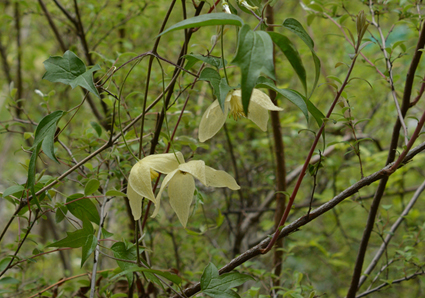Abstract
Clematis brevipes (Ranunculaceae), described from southern Gansu province, China, is an interesting and yet imperfectly understood species, with some of its important morphological characters, detailed geographical distribution and habitat information unknown or inconsistently recorded. Based on careful observations of both herbarium specimens (including type material) and living plants in the wild, here we determine the number of leaflets and color of flowers of this species and its geographical distribution. The habitat information is also given for this species for the first time. Furthermore, we discuss aspects of typification of C. brevipes and the affinity of the species with its close allies.
References
- Bachman, S., Moat, J., Hill, A.W., Torre, J. de & Scott, B. (2011) Supporting red list threat assessments with GeoCAT: geospatial conservation assessment tool. ZooKeys 150: 117−126. https://doi.org/10.3897/zookeys.150.2109
- Candolle, A.P. de (1818) Clematis. In: Candolle, A.P. de (Ed.) Regni Vegetabilis Systema Naturale, vol. 1. Treuttel & Würtz, Paris, pp. 131–163.
- Chang, M.C. (1980) Clematis L. In: Wang, W.T. (Ed.) Flora Reipublicae Popularis Sinicae, vol. 28. Science Press, Beijing, pp. 74–235.
- Franchet, A. (1894) Plantes nouvelles de la Chine occidentale. Journal de Botanique 8: 273–286.
- Grey-Wilson, C. (2000) Clematis The Genus. Timber Press, Oregon, 224 pp.
- Handel-Mazzetti, H. (1939) Plantae sinensis a Dre. H. Smith annis 1921–1922, 1924 et 1934 lectae. XXXIII. Ranunculaceae. Acta Horti Gotoburgensis 13: 37–219.
- IUCN Standards and Petitions Committee (2022) Guidelines for Using the IUCN Red List Categories and Criteria. Version 15.1. IUCN Standards and Petitions Committee. Available from: http://cmsdocs.s3.amazonaws.com/RedListGuidelines.pdf (accessed: 1 June 2023).
- Johnson, M. (1997) Släktet Klematis. Magnus Johnsons Plantskola AB, Södertälje, 881 pp.
- Johnson, M. (2001) The Genus Clematis. Magnus Johnson Plantskola AB and Bengt Sundström, Södertälje, 896 pp.
- Lehtonen, S., Christenhusz, M.J.M. & Falck, D. (2016) Sensitive phylogenetics of Clematis and its position in Ranunculaceae. Botanical Journal of the Linnean Society 182: 825–867. https://doi.org/10.1111/boj.12477
- Linnaeus, C. (1753) Species Plantarum. Laurentii Salvii, Holmiae, 1200 pp.
- Maximowicz, C.J. (1890) Plantae chinenses Potaninianae nec non Piasezkianae. Trudy Imperatorskago S.—Peterburgskago Botaničeskago Sada 11: 1–112.
- McNeill, J. (2014) Holotype specimens and type citations: General issues. Taxon 63: 1112−1113. https://doi.org/10.12705/635.7
- Miikeda, O., Kita, K., Handa, T. & Yukawa, T. (2006) Phylogenetic relationships of Clematis (Ranunculaceae) based on chloroplast and nuclear DNA sequences. Botanical Journal of the Linnean Society 152: 153–168. https://doi.org/10.1111/j.1095-8339.2006.00551.x
- Rehder, A. (1928) Enumeration of the plants collected by J. F. Rock on the Arnold Arboretum Expedition to the northwestern China and northeastern Tibet. Journal of the Arnold Arboretum 9: 37–125. https://doi.org/10.5962/p.333847
- Schneider, C.K. (1906) Clematis L. In: Schneider, C.K. (Ed.) Illustriertes Handbuch der Laubholzkunde. Gustav Fischer, Jena, pp. 273–294.
- Turland, N.J., Wiersema, J.H., Barrie, F.R., Greuter, W., Hawksworth, D.L., Herendeen, P.S., Knapp, S., Kusber, W.-H., Li, D.-Z., Marhold, K., May, T.W., McNeill, J., Monro, A.M., Prado, J., Price, M.J. & Smith, G.F. (2018) International Code of Nomenclature for algae, fungi, and plants (Shenzhen Code). Regnum Vegetabile 159. Koeltz Botanical Books, Glashütten, 254 pp. https://doi.org/10.12705/Code.2018
- Wang, W.T. (1998) Notulae de Ranunculaceis sinensibus (XXII). Acta Phytotaxonomica Sinica 36: 150–172.
- Wang, W.T. (2002) A revision of Clematis sect. Cheiropsis (Ranunculaceae). Acta Phytotaxonomica Sinica 40: 193–241.
- Wang, W.T. (2005) A new system of classification of the genus Clematis (Ranunculaceae). Acta Phytotaxonomica Sinica 43: 431–488. https://doi.org/10.1360/aps040130
- Wang, W.T. & Bartholomew, B. (2001) Clematis Linnaeus. In: Wu, Z.Y., Raven, P.H. & Hong, D.Y. (Eds.) Flora of China, vol. 6. Science Press, Beijing & Missouri Botanical Garden Press, St. Louis, pp. 333–386.
- Xie, L., Wen, J. & Li, L.Q. (2011) Phylogenetic analyses of Clematis (Ranunculaceae) based on sequences of nuclear ribosomal ITS and three plastid regions. Systematic Botany 36: 907–921. https://doi.org/10.1600/036364411X604921


